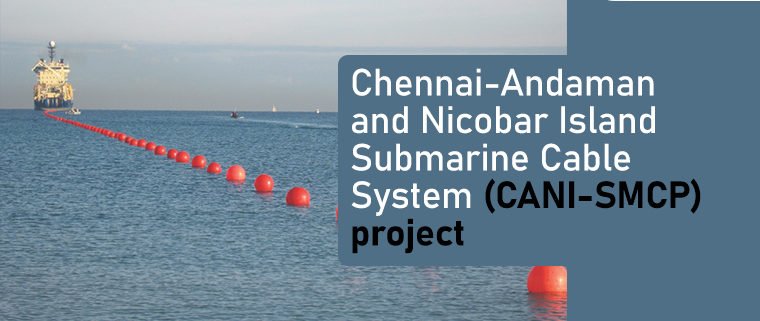In News- Recently, the Prime Minister launched a submarine optical fibre cable connecting Andaman & Nicobar Islands with the mainland.
- The optical fibre cable will give residents of the islands a faster Internet connection.
What is Submarine Communication Cable?
- A submarine communications cable is a cable laid on the sea bed between land-based stations to carry telecommunication signals across stretches of ocean and sea.
- These cables use optical fibre technology to carry digital data, which includes telephone, Internet and private data traffic.
- They are laid down by using specially-modified ships that carry the submarine cable on board and slowly lay it out on the seabed
- The first submarine communications cables laid beginning in the 1850s carried telegraphy traffic, establishing the first instant telecommunications links between continents, such as the first transatlantic telegraph cable which became operational on 16 August 1858.
What is Optical Fibre?
- It is used to transmit data using light pulses travelling along with a long fibre which is usually made of plastic or glass.
- The fibre optical cable uses the application of total internal reflection of light. The fibres are designed such that they facilitate the propagation of light along with the optical fibre depending on the requirement of power and distance of transmission.
Key details about the Project:
- It was launched on 30 December 2018 and has been completed before its designated deadline.
- It is a 2300 Kms long submarine cable will boost the endless opportunities in the Andaman & Nicobar Islands by providing better internet & mobile connectivity including 5G.
- It will also connect Port Blair to Swaraj Dweep (Havelock), Little Andaman, Car Nicobar, Kamorta, Great Nicobar, Long Island, and Rangat.
- The estimated cost of the project is Rs 1,224 crore and the bulk of the fibre has been sourced from NEC Corporation Japan. The company has also provided technical assistance during the installation.
- Outcomes- Submarine OFC link will deliver bandwidth of 2 x 200 Gigabits per second (Gbps) between Chennai and Port Blair, and 2 x 100 Gbps between Port Blair and the other islands.
- The Indian Ocean and the Andaman & Nicobar Islands had been important centres for trade and strategic cooperation. The Andaman & Nicobar Islands had an important role to play in India’s “Act East”.
- This will help A&N in getting cheaper & better connectivity and all the benefits of Digital India, especially in improving online education, telemedicine, banking system, online trading and in boosting tourism.

Benefits of the Project:
- Experts have an opinion that this move will open up a host of opportunities for India in the ASEAN region, where China provides a majority of the submarine optical fibre.
- The cable system with the incremental submarine length of 1,050 km can take connectivity to the nearest port of Thailand.
- India will gain politically if 1,925 km of incremental submarine cable can connect three ASEAN countries such as Myanmar, Thailand and Indonesia.
- This will increase the connectivity in the region and further facilitate e-governance services such as telemedicine and tell education.
- It is expected to play an instrumental role under India’s new trade strategy for the Indo-Pacific region.
- The system route, if extended, to three countries, as suggested along with OFC ring architecture in select ASEAN countries will bring in many more projects for the Indian domestic manufacturing industry.
- The internet bills in Andaman and Nicobar will also come down eventually.
Other important projects for Andaman & Nicobar Islands:
- Several projects are in progress including the enhancement of the capacity of the Port Blair airport, new airports at Diglipur, Car Nicobar and Campbell Bay, and passenger terminals at Swaraj Dweep, Shaheed Dweep and Long Island.
- The islands would be developed as a hub of “port-led development” as they were located at a competitive distance from many other ports.
- The Island Development Agency was formed in 2017 under the aegis of Ministry of Home Affairs to look into the holistic development of islands. Home Minister of India is its chairman and CEO of NITI Aayog (Amitabh Kant at present) acts as its convener.

